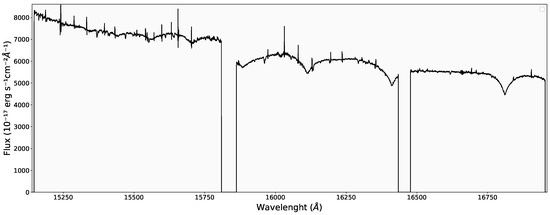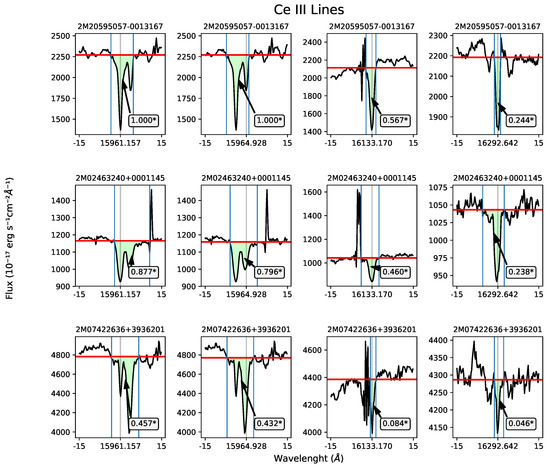Abstract
Like other disciplines, Astronomy faces the era of Big Data, where the analyses and discovery of specific objects is a significant and non-trivial matter. The APOGEE survey and Gaia mission are good examples of how these kind of projects have increased the amount of data to be managed. In this context, we have developed an algorithm to search for specific features in the APOGEE database. The main purpose is to seek spectral lines both in absorption or emission, in the whole APOGEE database, in order to find chemically-peculiar stars. We propose an algorithm which has been validated using cerium lines and we have applied it to the search for other chemical compounds.
1. Introduction
The Apache Point Observatory Galactic Evolution Experiment (APOGEE) [1] is a galactic survey focused on the structure and evolution of the Milky Way galaxy using high-resolution infrared spectroscopy. It aims to observe a very extensive star dataset in a late stage of stellar evolution to study its chemical composition and physical structure. APOGEE is a phase of a wider project, named Sloan Digital Sky Survey (SDSS), whose objective is to create the most detailed three-dimensional map of our galaxy [2].
We have used the fourth spectroscopic release from APOGEE, called Data Release 14 (DR14), which contains data for approximately 263.000 APOGEE targets. Each star includes spectra, derived stellar parameters, as well as elemental abundances for most of the stars. To develop our algorithm we have only used spectra data.
Our aim is to develop an algorithm to search for peculiar targets. To achieve this objective, we have applied signal processing techniques to stellar spectra, which can reveal many features of stars such as their chemical composition. We focused on detect spectral lines, which are used to identify the presence of atoms and molecules in stellar objects. For each chemical element present in a galactic target, there will be spectral lines in one or several wavelengths. The algorithm searches for these lines in the wavelengths of interest, and it has been developed to be able to seek any chemical compound.
2. Methods
The algorithm uses methods to detect specific features, categorizing and filtering each detection by means of different thresholds defined based on the local values of the signal.
For each wavelength where there can be located a spectral line, a window for local analysis is created. We apply morphological analysis for their extraction. First, we look for peaks—or valleys—close to these wavelengths, defining a threshold calculated from the signal continuum and their variance to avoid the detection of false positives due to noise or very rippled spectra. Secondly, the area of the candidate line is calculated and normalized according to continuum, with the aim of filtering lines with little width and/or height. The detection of a line is considered positive when both steps are achieved. Furthermore, the algorithm is configurable, in order to allow the user to define a great deal of parameters to search for different types of objects. The user can:
- Search for any list of lines of interest from their wavelengths.
- Search for emission or absorption lines.
- Choose the minimum number of lines which should be detected over the total to consider a positive case
- Determine critical lines which must be detected in all objects. If these lines are not detected in the spectrum, it would not be a positive case, even though the number of the other detections exceeded the minimum.
- Define the size of the local analysis window.
- Establish the minimum value of the normalized area that the lines must satisfy.
As it can be seen in Figure 1, spectra present two gaps without flux. These absences of data are the result of the wavelength coverage in APOGEE detectors, since spectra are recorded onto three separate detectors, which do not cover the full infrared H band. Some lines could appear within these gaps but, as the range of the gaps can vary slightly, sometimes they are added as an optional lines to seek. If they are distinctly located within these bands, we discard them.

Figure 1.
APOGEE Spectrum.
3. Results
We tested the algorithm searching for cerium III compound (Ce III), which can present several lines in a spectrum. In order to validate it, we have compared our result with the detections of Chojnowski et al., who report 157 chemically-peculiar stars with Ce III absorption lines [3]. Our exploration detected 105 stars in common with measurements taken by Chojnowski. In addition, we detected 975 new objects with presence of cerium. The results were obtained using the parameters shown below:
- Lines: 15,961.157, 15,964.928, 16,133.170, 16,292.642 Å.
- Type of lines: Absorption lines.
- Minimum number of lines: 4 (All lines are considered critical).
- Window size: 30 Å.
- Minimum area: 0.020.
- Total detections: 1080 stars.
In Figure 2 it is shown several stars with Ce III lines.

Figure 2.
Ce III Lines. Each row shows a single target with cerium lines.
After validation, the algorithm has been used to find other chemically peculiar stars. In order to ensure the quality of the search and in accordance with the nature of each chemical compound, it has been mandatory to adjust individually the parameters of the algorithm.
4. Conclusions
On balance, we have designed and tested an algorithm whose aim is provide a useful tool to help in the search of chemically peculiar stars as it has been seen in more detail above. We are working to improve the calibration in the validation stage in order to achieve better and more reliable results and to avoid false positive cases. Moreover, we have obtained promising results searching for rarer elements, which have to be studied in detail and may be important enough to be published in the future. Also, we want to combine morphological analysis with Artificial Intelligence techniques to enhance feature extraction, allowing to discover new peculiar stars.
Funding
This work was supported by the Spanish Ministry of Science Innovation and the Ministry of Economy, Industry and Competitiveness (RTI2018-095076-B-C22 and ESP2016-80079-C2-2-R) and by the Xunta de Galicia (Potencial Crecemento ED431B 2018/42) and the European Union (European Social Fund—ESF).
Conflicts of Interest
The authors declare no conflict of interest. The funders had no role in the design of the study; in the collection, analyses, or interpretation of data; in the writing of the manuscript, or in the decision to publish the results.
References
- Majewski, S.R.; Schiavon, R.P.; Frinchaboy, P.M.; Prieto, C.A.; Barkhouser, R.; Bizyaev, D.; Blank, B.; Brunner, S.; Burton, A.; Carrera, R.; et al. The Apache Point Observatory Galactic Evolution Experiment (APOGEE). Astron. J. 2017, 154, 94. [Google Scholar] [CrossRef]
- Blanton, M.R.; Bershady, M.A.; Abolfathi, B.; Albareti, F.D.; Prieto, C.A.; Almeida, A.; Alonso-García, J.; Anders, F.; Anderson, S.F.; Andrews, B.; et al. Sloan Digital Sky Survey IV: Mapping the Milky Way, Nearby Galaxies, and the Distant Universe. Astron. J. 2017, 154, 28. [Google Scholar] [CrossRef]
- Chojnowski, S.D.; Hubrig, S.; Hasselquist, S.; Castelli, F.; Whelan, D.G.; Majewski, S.R.; Nitschelm, C.; García-Hernández, D.A.; Stassun, K.G.; Zamora, O.; et al. Discovery of Resolved Magnetically Split Lines in SDSS/APOGEE Spectra of 157 Ap/Bp Stars. Astron. J. Lett. 2019, 873, L5. [Google Scholar] [CrossRef]
Publisher’s Note: MDPI stays neutral with regard to jurisdictional claims in published maps and institutional affiliations. |
© 2019 by the authors. Licensee MDPI, Basel, Switzerland. This article is an open access article distributed under the terms and conditions of the Creative Commons Attribution (CC BY) license (https://creativecommons.org/licenses/by/4.0/).